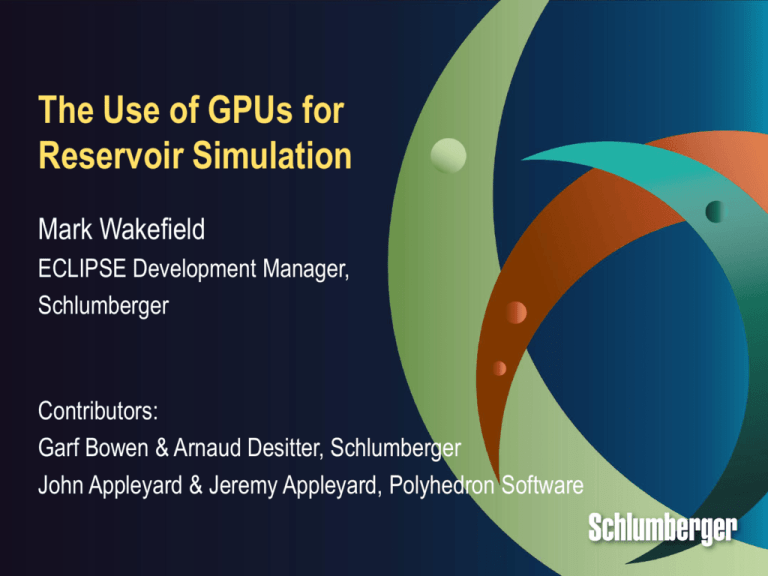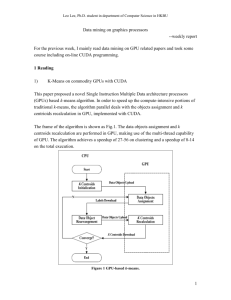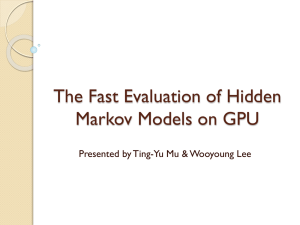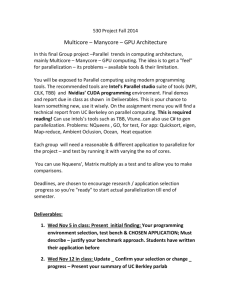
The Use of GPUs for
Reservoir Simulation
Mark Wakefield
ECLIPSE Development Manager,
Schlumberger
Contributors:
Garf Bowen & Arnaud Desitter, Schlumberger
John Appleyard & Jeremy Appleyard, Polyhedron Software
© 2011 Schlumberger. All rights reserved.
An asterisk is used throughout this presentation to denote a mark of Schlumberger.
Other company, product, and service names are the properties of their respective
owners.
2
Schlumberger Abingdon Tech. Center
Based 8 miles from Oxford, UK
~200 employees involved in developing oilfield software
~50 people involved in commercial simulator development
– ECLIPSE*: Established FORTRAN/MPI code focusing on high
end physics
– INTERSECT*: New to market C++/MPI code focusing on
scalability and large model workflows
GPU Technology Evaluation
Have been evaluating GPU technology for the past 2+ years,
particularly the NVIDIA CUDA architecture
1.
How can GPUs be used in existing commercial products
2.
Considerations for algorithm design
3.
Considerations for software engineering
Simulator Overview
Evolutionary, timesteps from an initial state
Solves a set of non-linear conservation equations
Solved implicitly due to fast propagating pressure transients
Newton iteration requires solution of linear system
Solution of linear system is critical to performance but not
naturally parallel
Models routinely have 10^4 – 10^7 grid blocks
Timestep Loop to Find Solution x at t + Δt
1) Property calculations from x
2) Residual and Jacobian assembly
rcomp(x)
ccomp
t
(x)
Accumulation
f comp(x)
Flux
3) Linear solve to find solution increment
r
δx r,
x
x x δx
wcomp(x)
Source
Source / Sinks
Suitable Components to Migrate to GPU
Component
% run time & % code
base
Type of algorithm
Property
calculations
15-30% run time
15+15% code base
Ratio ~ 1
Largely independent cell calculations
for fluid properties. Also includes well
model. Many branches depending on
model
Matrix Assembly
15 – 20% run time
1% code base
Ratio ~ 15
Independent assembly of governing
equations for each cell
Linear Solver
50 – 70% run time
2% code base
Ratio ~ 30
Most potential but also the most
sequential part of the code
GPU Linear Solver Components
CUDA FP performance
CUDA memory bandwidth
30
80
70
25
60
GB/s
50
Product
Factor
Solve
Guide
40
30
20
10
0
Gflops
20
Product
Factor
Solve
Guide
15
10
5
0
500
5000
50000
Number of Threads
500
5000
50000
Number of Threads
Should We Write a GPU Linear Solver?
OpenMP vs CUDA
Milliseconds
100
OpenMP Product
OpenMP Factor
OpenMP Solve
CUDA Product
CUDA Factor
CUDA Solve
10
1
0.1
1
10
100
1000
10000
100000
Number of threads
Intel Xeon X5482 & NVIDIA Tesla C1060
Potential Demonstrated
Ideas evolved into the Massively Parallel Nested
Factorization (MPNF) algorithm
Presented at the 2011 SPE RSS
– Accelerating Reservoir Simulators using GPU Technology,
John R. Appleyard and Jeremy D. Appleyard, Polyhedron
Software, and Mark A. Wakefield and Arnaud L. Desitter,
Schlumberger (SPE-141402-PP)
Results generated on an Intel Xeon X5550 with a NVIDIA
Tesla C2050
Iterative Linear Solver Essentials
Solve Mx = r, constructing the solution in terms of a small
number of basis vectors (v)
~
x i vi
M~
x r
Performance depends on the ability to generate good v’s
Preconditioner N is an easy to invert approximation to M
Error in x
M
N 1
Error in r
N often a factorization (LU) which is essentially a serial algorithm
A GPU Based Preconditioner
Color order grid so that columns are independent
A
B
C
D
All columns in a color can be factored in parallel. Solve Ny=r as
A
sR rR
C D s r
B B
I
A1 B yR sR
I E yB sB
GPU Linear Solver Performance
Compared with serial CPU solver on a suite of 30 models
with up to 900k grid blocks
All models ran to completion with comparable results
50% more linear iterations
10% non-linear iterations & 10% more timesteps
Due to trade off between parallelization and accuracy of
preconditioner.
Speed-up for Linear Solver Only
100.00
Solver Speed-up
10.00
1.00
1E+0
1E+1
1E+2
1E+3
1E+4
1E+6
Want to be
operating here
but GPU memory
is a constraint
0.10
0.01
1E+5
Number of Grid Blocks
Overall Speed-up with GPU Linear Solver
10
9
Overall Speed-up
8
7
6
5
4
3
2
1
0
1.00E+05
1.00E+06
Number of grid blocks
Next Step – Assembly on the GPU
12
16
10
12
Overall speed-up
Assembly speed-up
14
10
8
6
GPU Solver
8
6
GPU Solver
and
assembly
4
4
2
2
0
1.00E+05
1.00E+06
Number of grid blocks
0
1.00E+05
1.00E+06
Number of grid blocks
GPU Technology Evaluation Conclusions
How can GPUs be used in existing commercial products
1.
–
With modest effort we can achieve a ~3x speed-up
2.
Considerations for algorithm design
3.
Considerations for development/architecture frameworks
Algorithm Design - Linear Solver Scalability (I)
Problem size fixed, increase number of GPUs
MPNF is algorithmically unchanged by a domain decomposition
layer:
Process same color simultaneously across all domains
corrections between colors are passed both within and
between domains
Same iteration count whether on one machine, or a cluster
Under exploration
Algorithm Design - Linear Solver Scalability (II)
Problem size increasing, fixed number of GPUs
MPNF has shown good scalability but GPU memory is a
constraint on testing
MPNF is not as recursive as a multi-grid algorithm.
SLB currently working on massively parallel recursive
algorithms that might exhibit better scalability on very large
problems
Software Engineering – Past Experiences
Scientific code can have a long life time
Clients still run old versions & models
Working with non-proprietary standards has
enabled ECLIPSE* to adapt to:
OS changes
Hardware changes
Interconnect changes
Software Engineering - Past Experiences
Simulator developers are not generally Computer Scientists
so need an effective environment where performance comes
naturally
Developers swap projects – need a productive environment
Continue to explore pros/cons of other solutions:
Alternative hardware targets - Intel ArBB
Platform neutral approaches - Oxford Parallel Library (OP2)
Higher level implementations - CUDA Thrust
GPU Technology Evaluation Conclusions
How can GPUs be used in existing commercial products
1.
–
With modest effort we can achieve a ~3x speed-up
Considerations for algorithm design
2.
–
Have demonstrated that existing algorithms can be adapted.
Massively parallel algorithms still an area of internal research.
Considerations for software engineering
3.
–
Not yet obvious - but we know the cores are coming!











